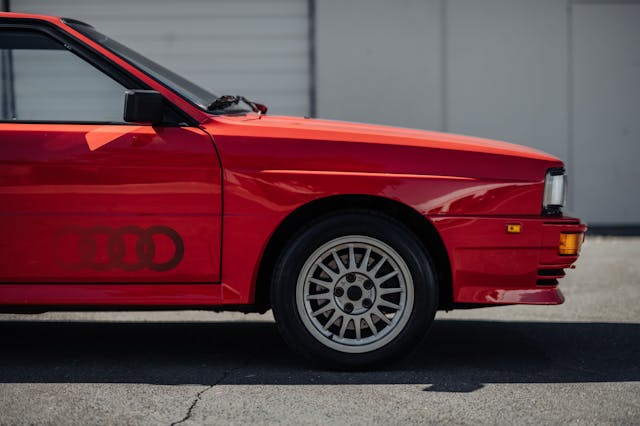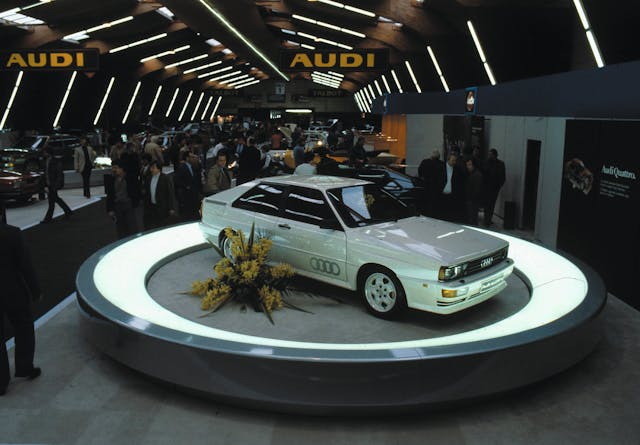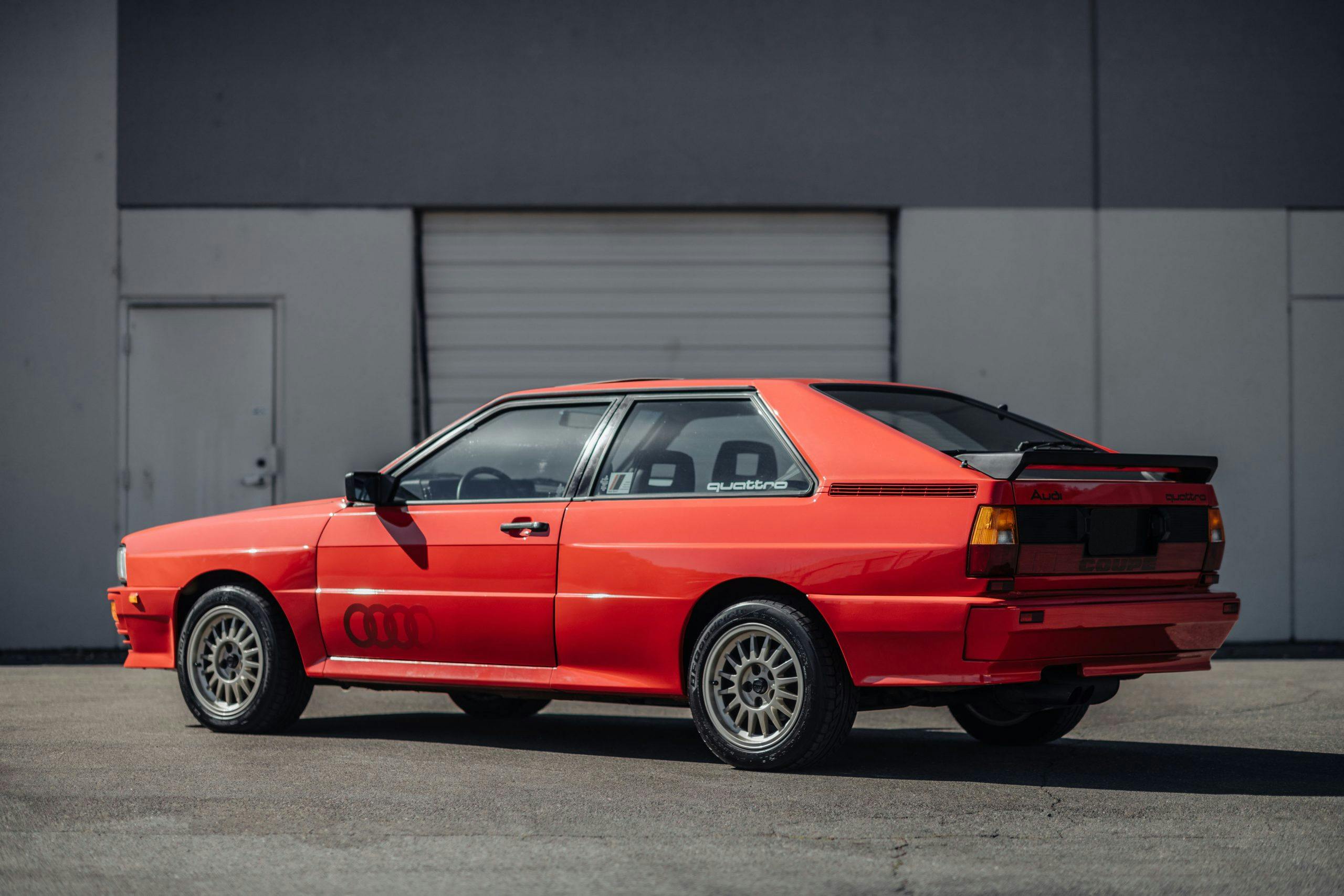Media | Articles
Audi’s Ur-Quattro, trend-setter on the rally stage and street, is fast becoming a blue-chip ’80s classic
Spit a sunflower seed in any direction in 2021, and you’ll probably hit a passenger car with a small-displacement turbo engine and all-wheel drive. In 1980, not so much. At the time, all-wheel drive meant heavy transfer cases, high ground clearance, and lots of extra weight. Two-wheel drive was king. So when the first Quattro hit the scene in 1980, its combination of aggressive style, compact size, and confident all-weather handling landed Audi a surprise hit. Four decades on, quattro all-wheel drive is essentially synonymous with the four-ringed brand that invented it, and the so-called “Ur-” (German shorthand for “original”) Quattro is one of the hottest 1980s sports cars in the market.
The Quattro’s legacy, however, isn’t as the Teutonic progenitor or engineering inspiration for today’s mainstream conveyances. A boxy two-door with a 200-hp single overhead-cam five-cylinder and a manually operated mechanical locking differential has about as much in common with a new Subaru Forester as Tokyo does with Ingolstadt. No, people celebrate this gravel-scrambling innovator because of its impact on international rallying, a stage upon which Audi built a lasting reputation for high performance and technology.

Naturally, it’s the Quattro’s fiberglass-bodied, Kevlar-reinforced, and boosted-to-high-heaven homologation special that commands iconic status today. Known as the Sport Quattro, this short-wheelbase, 302-hp dynamo was built to satisfy rules for Audi’s entry into Group B for 1984. It featured two valves per cylinder and an aluminum block, plus wider fenders and wider wheels than standard. Despite being extreme in every sense, the Sport Quattro wasn’t super-successful in the World Rally Championship (WRC) against the intensely competitive Group B field. It found much greater success in later hill climbs at Pikes Peak.
In fact, the earlier long-wheelbase car was much more successful in rallying, winning the four World Rally Championship titles over the course of three years, including Group B manufacturers’ title in 1982 and the drivers’ title in 1984 for Stig Blomqvist. It also showed the way of the future by being the first all-wheel drive car to win the WRC. Other than a brief triumph by the rear-drive Lancia 037 in 1983, no two-wheel drive car has won the title since.
Marketplace
Buy and sell classics with confidence

The genius behind the Quattro was the simplicity and cleverness of its engineering and design. In 1977, prompted by the snow-driving prowess of the VW Iltis military vehicle, Audi chassis engineer and experimental running gear manager Jörg Bensinger hit upon the idea of a road-car with full-time four-wheel drive. Working with project director Walter Treser, and under chief technical director Ferdinand Piëch, Bensinger began work on an Audi 80-based prototype employing the Iltis’ drive design. Initial tests proved the potential of the all-wheel-drive system, but the locked axles compromised handling. Seeking to keep weight and complexity down, Audi’s breakthrough came when transmission design head Franz Tregler came up with the solution of a hollow secondary shaft in gearbox that would enable power deliver to both axles via a differential at each end. Quattro was born.
After the successful launch at the end of 1980, Audi continually improved the Quattro with better materials, lighting, and interior tweaks, including revisions to the steering wheel, center console and even a digital dashboard with an LCD screen for 1983. Exterior changes were minor during its 11-year run, though the biggest shift came in 1985 with updates to the grille, headlights, and trim. 1987 brought a Torsen center differential to replace the manual locking setup, as well as a barely larger 2.2-liter turbo inline-five engine with the same 197-hp but improved low-end torque. Finally, 1989 heralded the arrival of the engine’s four-valve head and dual-overhead cam, which bumped power to 227 horses and top speed to 143 mph. All Quattros, early and late, came with a five-speed manual.

Quattros aren’t exactly rare, with 11,452 built over the model run, but that doesn’t tell the whole story. Only 664 were sold in the U.S. following the Quattro’s North American debut for the 1983 model year (compared to 224 Sport Quattros, which never sold in the U.S.). In addition to impact bumpers, air conditioning, and leather seating surfaces, these cars employed a modified 2.1-liter engine with lower boost, a different camshaft, and various emissions-control modifications that served to lower output to 160 hp. After 1986 the Ur-Quattro was gone from our shores, so to get one with the later upgrades you would either have to import a post-1986 or build your own.
The market for vintage Quattros market was fairly tame until 2015, when one of the homologation Sport Quattros sold for $401,500 at an RM Sotheby’s auction and lit this model on fire. Compared to 10 years ago, #2-condition (Excellent) values for these short-wheelbase cars are up 415 percent, to $458,000 as of this month, with the bulk of that jump taking place in the immediate aftermath of the RM sale. Other ultra-rare Group B-era homologation cars have followed suit and appreciated over the past few years, too.

But what’s been especially interesting to watch is how the Sport Quattro’s rise has trickled down to the Ur-Quattro. Over the same 10-year stretch period, #2 values of the standard 1983–85 Audi Quattro increased 237 percent, climbing from just under $20,000 to $55,600 today. The best result this year came from an American car later updated to Euro spec, selling for $61,600 at RM Sotheby’s Arizona sale in January. Growth for the standard Quattro has been more steady over the last decade than that of the Sport Quattro, owing in part to the major disparity in volume between the two variants. Things have been especially good for the Ur-Quattro in the last four years, during which time values blossomed from $40,400 to their current level. Hagerty insurance quotes are also up 150 percent since 2017, suggesting interest in these cars only continues to grow. But it’s also interesting to note that most of this growth has been for cleaner examples, while movement for condition-#4 (Fair) cars has been quiet. For better or worse, these cars were partially hand-built on a dedicated line in Ingolstadt. Interior quality wasn’t the best, electrics were iffy, and heat soak after hard runs could cook oil and create problems with the turbo. Plus, parts and repair on these old Audis is not for the faint of heart, so most buyers on the hunt for one are springing for cleaner examples.
Interest in 1980s sports cars has been on the rise over the last several years, and that trend shows no signs of slowing down. The Quattro has therefore gotten a lot of attention, and for good reason. It’s boxy, it’s edgy, and it melds forward-thinking engineering with a turbocharged punch from a distinctive and great-sounding five-cylinder mill. Audi’s role in bringing proven motorsports technology to the street was arguably the most significant stepping stone in popularizing all-wheel drive in passenger cars, which quickly spread across the brand’s lineup as a trademark feature following the success of the Ur-Quattro. This is as important of a car for Audi as it is for the history of rallying and all-wheel drive in general. No doubt they’ll be in demand for years to come, and given their rarity, performance and significance, they still have room to grow.








